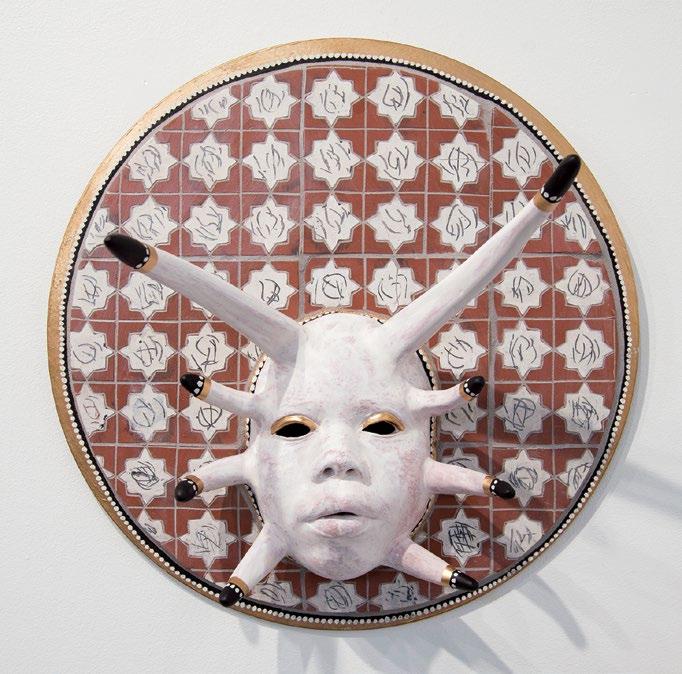
5 minute read
A Multimedia Home Studio
A MULTIMEDIA HOME STUDIO Joann Quiñones
Editors: What techniques do you use to make your work and why? Joann Quiñones: I love slip casting and mold making. It is poetic and labor intensive. Conceptually, both techniques are still relevant to me as I think about the dehumanization of individuals in terms of both race and labor. The circumstances of the past year, however, have really impacted what kind of work I can make. Between transitioning into a home studio setup and a pandemic, it felt like so many avenues were closed—from the businesses where I could purchase supplies to facilities where I could have pieces fired. And yet, because artists are generous with their time, knowledge, and resources, I found I was really able to branch out and try new things.
Advertisement
I have taken a wide range of workshops and classes online this past year during quarantine, from glaze chemistry to sculpting on a wheel. Through this process, I discovered that I have seriously underestimated things like press molds, the sculptural possibility of thrown objects, the value of making smaller work (especially when you only have a tiny kiln), and making larger works constructed

1
2

4

3
of parts. And the slower pace has meant I have been able to give attention to things like making tiles and stamps. I am practicing surface design on both clay and fiber, and I am enjoying researching historical patterns. Even if these choices are happening because of circumstances outside my control, I am able to make work I care about. I still find myself lifecasting and making molds of body parts. I don’t think that will ever change, but I’m looking forward to seeing how this incubation period will impact how I approach the body.

Eds: What materials do you use in your work and what role do they play in the narrative? JQ: I have transitioned to only using terra cotta in my work. Narratively, the material helps me connect to places as diverse as West Africa and Spain, and temporally to the Pre-Columbian era. It has been used to make functional ware, sculpture, and architectural elements, from the roof to the floor. I think of
Anyone who is willing to question the narratives of history, who can ask, ‘Who is present, who is missing, and what is their story?’—that’s my ideal audience.” “
it as a material that is the foundation of the work. And because in my work I try to convey what it is like to live in the crossroads in terms of gender, race, and cultures, I love how it helps me remember we are all connected in some way through our traditions with the same material. I also have switched to using only terra-cotta casting slip. There is a fantastic recipe in Andrew Martin’s book Essential Guide to Mold Making and Slip Casting. In the past year, I have fallen madly in love with terra sigillata, and because of how it mimics some qualities of skin for me, it has started appearing on my forms more often.
I have noticed I am developing a larger mixed-media sculpture practice. I am gravitating toward fibers and wood for the same reason I love clay. Objects and materials have history. The way I choose to assemble them helps me enter that conversation. This is what makes art so powerful to me.
Eds: Who is your ideal audience? How do you hope to engage that audience? JQ: In general, I want my ideal audience to be everyone, but as I have taken on more specific projects, I’m realizing imagining that audience is an important first step. For example, I worked on a project called Seeing Lizzie as part of “Call and Response: Creative Interpretations of Wylie House.” The Wylie House is a historic house museum administered by Indiana University Libraries, under the direction of Carey Champion. It was the home of Indiana University’s first president, Andrew Wylie. Elizabeth Breckenridge was an African American domestic servant who lived in the Wylie House for 54 years. When I visited the house, there was nothing physically I could see to mark her presence, even though her labor and her care for the family was vital.
I created artworks for almost every room in the house, so that visitors would have the opportunity to imagine and wonder what Lizzie’s life was like. I made a series of topsy-turvy dolls to place in the girls’ bedroom to highlight even though Elizabeth came to the Wylie House at 14 years old, her life was much different than the girls of the home. I made tiles and tiled a broom that was placed in the corner of the master bedroom. In order to engage the audience, next to each artwork were NFC tags. Visitors could use their smartphones and be directed to websites, photographs, and articles about Elizabeth and Black life in the 19th century. With this project, it became really clear that I wanted people who may have never seen
6
6 These Hands Do Not Work Here, 10 ft. 4 in. (3.2 m) in length, terra-cotta casting slip, wood, paint, ribbon, whitewash, 2020. Photo: Destini Ross. 7 American Ibeyi, 16 in. (41cm) in height, terra cotta, acrylic, cotton, 2020. 8 Topsy, 10 in. (25 cm) in height, terra cotta, cotton, lace, music box that plays “Jesus Loves Me,” 2020. 9 Jump: Broom: Swept, 4 ft. 6 in. (1.4 m) in height, white earthenware, floral decals, grout, broom, 2020. 7–9 Courtesy of the Wylie House Museum.

7













